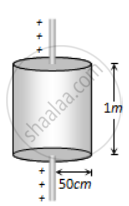Advertisements
Advertisements
प्रश्न
Mark out the correct options.
पर्याय
The total charge of the universe is constant.
The total positive charge of the universe is constant.
The total negative charge of the universe is constant.
The total number of charged particles in the universe is constant.
उत्तर
The total charge of the universe is constant.
According to the principal of conservation of charge, the net amount of positive charge minus the net amount of negative charge in the universe is always constant. Thus, the total charge of the universe is constant. The total positive charge of the universe may increase or decrease, depending on the total increase or decrease in negative charge. This is the principle of conservation of charge that is universal in nature.
APPEARS IN
संबंधित प्रश्न
Two large conducting plates are placed parallel to each other with a separation of 2⋅00 cm between them. An electron starting from rest near one of the plates reaches the other plate in 2⋅00 microseconds. Find the surface charge density on the inner surfaces.
Choose the correct option.
A charge of + 7 μC is placed at the centre of two concentric spheres with radius 2.0 cm and 4.0 cm respectively. The ratio of the flux through them will be
Choose the correct option.
Two point charges of +5 μC are so placed that they experience a force of 8.0 × 10-3N. They are then moved apart so that the force is now 2.0 × 10-3N. The distance between them is now
Two parallel plates have a potential difference of 10 V between them. If the plates are 0.5 mm apart, what will be the strength of electric charge.
A conducting sphere of radius 0.104 m has an unknown charge. If the electric field at 0.20 m from the centre of the sphere is 1.5 x 103 NC-1 and points radially inward, what is the electric flux?
A solid sphere of radius R1 and volume charge density `rho = rho_0/"r"` is enclosed by a hollow sphere of radius R2 with negative surface charge density σ, such that the total charge in the system is zero. `rho_0` is a positive constant and r is the distance from the center of the sphere. The ratio R2/R1 is ______.
Electric charge is uniformly distributed along a long straight wire of radius 1 mm. The charge per cm length of the wire is Q coulomb. Another cylindrical surface of radius 50 cm and length 1 m symmetrically enclose the wire as shown in the figure. The total electric flux passing through the cylindrical surface is ______.

Electric field lines provide information about ______.
When a glass rod is rubbed with silk, it ______.
Equal charge are given to two-sphere of different radii. The potential will be
Given below are two statements:
- Statement I: The electric force changes the speed of the charged particle and hence changes its kinetic energy; whereas the magnetic force does not change the kinetic energy of the charged particle.
- Statement II: The electric force accelerates the positively charged particle perpendicular to the direction of the electric field. The magnetic force accelerates the moving charged particle along the direction of the magnetic field.
In light of the above statements, choose the most appropriate answer from the options given below.
A certain charge Q is divided into two parts q and (Q - q). How should the charges Q and q be divided so that q and (Q - q) placed at a certain distance apart experience maximum electrostatic repulsion?
Two identical conducting spheres A and B, carry equal charge. They are separated by a distance much larger than their diameter, and the force between them is F. A third identical conducting sphere, C, is uncharged. Sphere C is first touched to A, then to B, and then removed. As a result, the force between A and B would be equal to ______.
A straight infinitely long cylinder of radius R0 = 10 cm is uniformly charged with a surface charge density σ = + 10-12 C/m2. The cylinder serves as a source of electrons, with the velocity of the emitted electrons perpendicular to its surface. Electron velocity must be ______ × 105 m/s to ensure that electrons can move away, from the axis of the cylinder to a distance greater than r = 103 m.
A particle of mass m and charge q is placed at rest in a uniform electric field E and then released. The kinetic energy gained by the particle after moving a distance of y will be ______.
